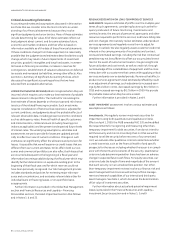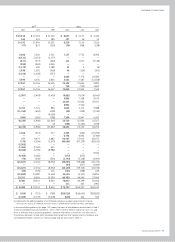GE 2011 Annual Report Download - page 67
Download and view the complete annual report
Please find page 67 of the 2011 GE annual report below. You can navigate through the pages in the report by either clicking on the pages listed below, or by using the keyword search tool below to find specific information within the annual report.’
GE 2011 ANNUAL REPORT 65
Long-Lived Assets. We review long-lived assets for impairment
whenever events or changes in circumstances indicate that the
related carrying amounts may not be recoverable. Determining
whether an impairment has occurred typically requires various
estimates and assumptions, including determining which undis-
counted cash fl ows are directly related to the potentially impaired
asset, the useful life over which cash fl ows will occur, their
amount, and the asset’s residual value, if any. In turn, measure-
ment of an impairment loss requires a determination of fair value,
which is based on the best information available. We derive the
required undiscounted cash fl ow estimates from our historical
experience and our internal business plans. To determine fair
value, we use quoted market prices when available, our internal
cash fl ow estimates discounted at an appropriate interest rate
and independent appraisals, as appropriate.
Our operating lease portfolio of commercial aircraft is a sig-
nifi cant concentration of assets in GE Capital, and is particularly
subject to market fl uctuations. Therefore, we test recoverabil ity
of each aircraft in our operating lease portfolio at least annually.
Additionally, we perform quarterly evaluations in circumstances
such as when aircraft are re-leased, current lease terms have
changed or a specifi c lessee’s credit standing changes. We
consider market conditions, such as global demand for com-
mercial aircraft. Estimates of future rentals and residual values
are based on historical experience and information received rou-
tinely from independent appraisers. Estimated cash fl ows from
future leases are reduced for expected downtime between leases
and for estimated technical costs required to prepare aircraft to
be redeployed. Fair value used to measure impairment is based
on manage ment’s best estimate. In determining its best estimate,
management evaluates average current market values (obtained
from third parties) of similar type and age aircraft, which are
adjusted for the attributes of the specifi c aircraft under lease.
We recognized impairment losses on our operating lease port-
folio of commercial aircraft of $0.3 billion and $0.4 billion in 2011
and 2010, respectively. Provisions for losses on fi nancing receiv-
ables related to commercial aircraft were an insignifi cant amount
for both 2011 and 2010.
Further information on impairment losses and our exposure to
the commercial aviation industry is provided in the Operations—
Overview section and in Notes 7 and 25.
Real Estate. We review the estimated value of our commercial real
estate investments at least annually, or more frequently as condi-
tions warrant. The cash fl ow estimates used for both estimating
value and the recoverability analysis are inherently judgmental,
and refl ect current and projected lease profi les, available industry
information about expected trends in rental, occupancy and
capitalization rates and expected business plans, which include
our estimated holding period for the asset. Our portfolio is diversi-
fi ed, both geographically and by asset type. However, the global
real estate market is subject to periodic cycles that can cause
signifi cant fl uctuations in market values. Based on the most recent
valuation estimates available, the carrying value of our Real Estate
investments exceeded their estimated value by about $2.6 billion.
Commercial real estate valuations in 2011 showed signs of
improved stability and liquidity in certain markets, primarily in the
U.S.; however, the pace of improvement varies signifi cantly by
asset class and market. Accordingly, there continues to be risk and
uncertainty surrounding commercial real estate values. Declines
in the estimated value of real estate below carrying amount result
in impairment losses when the aggregate undiscounted cash fl ow
estimates used in the estimated value measurement are below the
carrying amount. As such, estimated losses in the portfolio will not
necessarily result in recognized impairment losses. When we
recognize an impairment, the impairment is measured using the
estimated fair value of the underlying asset, which is based upon
cash fl ow estimates that refl ect current and projected lease pro-
fi les and available industry information about capitalization rates
and expected trends in rents and occupancy and is corroborated
by external appraisals. During 2011, Real Estate recognized pre-
tax impairments of $1.2 billion in its real estate held for
investment, as compared to $2.3 billion in 2010. Continued dete-
rioration in economic conditions or prolonged market illiquidity
may result in further impairments being recognized. Furthermore,
signifi cant judgment and uncertainty related to forecasted valua-
tion trends, especially in illiquid markets, results in inherent
imprecision in real estate value estimates. Further information is
provided in the Global Risk Management and the All Other Assets
sections and in Note 9.
Goodwill and Other Identifi ed Intangible Assets. We test good-
will for impairment annually and more frequently if circumstances
warrant. We determine fair values for each of the reporting units
using an income approach. When available and appropriate, we
use comparative market multiples to corroborate discounted
cash fl ow results. For purposes of the income approach, fair value
is determined based on the present value of estimated future
cash fl ows, discounted at an appropriate risk-adjusted rate. We
use our internal forecasts to estimate future cash fl ows and include
an estimate of long-term future growth rates based on our most
recent views of the long-term outlook for each business. Actual
results may differ from those assumed in our forecasts. We derive
our discount rates using a capital asset pricing model and analyz-
ing published rates for industries relevant to our reporting units to
estimate the cost of equity fi nancing. We use discount rates that
are commensurate with the risks and uncertainty inherent in the
respective businesses and in our internally developed forecasts.
Discount rates used in our reporting unit valuations ranged from
9.0% to 13.75%. Valuations using the market approach refl ect
prices and other relevant observable information generated by
market transactions involving comparable businesses.
























